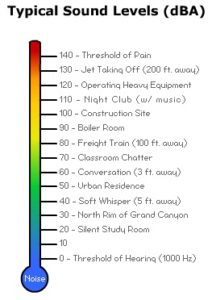One of the most common noise education resources out there is the dB thermometer. It’s also one of the most potentially confusing to the uninitiated.
A medical thermometer gives a general indication of “health” based on temperature alone, compared to a well-defined threshold of concern: fever.
 The thermometer format also works well for hearing conservation. Time-weighted shift-average A-weighted sound pressure level correlates well with potential hearing loss, and is easily compared to the exposure limit of 85 dBA. It’s obvious when the noise is excessive.
The thermometer format also works well for hearing conservation. Time-weighted shift-average A-weighted sound pressure level correlates well with potential hearing loss, and is easily compared to the exposure limit of 85 dBA. It’s obvious when the noise is excessive.
Medical thermometers can’t inform you about health problems that don’t present with fever. Likewise the dB thermometer doesn’t indicate anything about the character or context of the noise. Thus it can lead to the faulty impression that all sounds below about 70 dBA are just fine.
The use of thermometer dBA as a guide to annoyance is problematic because:
- dBA de-emphasizes low frequency,
- dBA disregards many important characteristics of sound,
- dBA doesn’t address the context in which the sound is heard.
For instance:
- 80 dBA of EDM has lots more bass and can penetrate walls more easily than 80 dBA of fiddle and mandolin.
- 60 dBA of babbling brook is less annoying than 60 dBA of fingernails on chalkboard.
- 70 dBA of lawnmower at 5 am is more annoying than 70 dBA at noon.
In truth, noise annoyance is usually based on amount, character, and context:
- loudness relative the current environment
- spectral shape including dissimilarity from the current environment
- tones and modulations
- low-frequency and/or infrasound
- impulses, other variations
- perceived “message” conveyed by the sound
Noise control design to improve acceptance typically addresses all of these factors and more.
Nelson Acoustics has extensive experience assessing and improving the sound quality of products, machines, and equipment. For best results sound quality can and should be considered at the outset.
Copyright 2020 Nelson Acoustics
Previous entries in the series “Myths, Misunderstandings, and Magical Thinking about Noise”:
